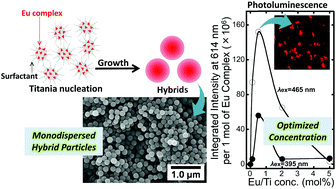当前位置:
X-MOL 学术
›
Dalton Trans.
›
论文详情
Our official English website, www.x-mol.net, welcomes your
feedback! (Note: you will need to create a separate account there.)
Preparation of Eu(iii) acetylacetonate-doped well-defined titania particles with efficient photoluminescence properties†
Dalton Transactions ( IF 3.5 ) Pub Date : 2018-01-18 00:00:00 , DOI: 10.1039/c7dt03035e Kota Shiba 1, 2, 3, 4, 5 , Takuya Kataoka 5, 6, 7, 8 , Motohiro Tagaya 5, 6, 7, 8
Dalton Transactions ( IF 3.5 ) Pub Date : 2018-01-18 00:00:00 , DOI: 10.1039/c7dt03035e Kota Shiba 1, 2, 3, 4, 5 , Takuya Kataoka 5, 6, 7, 8 , Motohiro Tagaya 5, 6, 7, 8
Affiliation

|
The aggregation/dispersion of luminescent species is a critical factor that determines their luminescence properties. In this study, europium(III) acetylacetonate (Eu(acac)3) was doped into a titania matrix to form Eu(acac)3-doped titania particles with well-defined size and shape through a microreactor-based sol–gel approach. The morphology and structure of the as-synthesized products were characterized by Fourier transform infrared spectroscopy, scanning electron microscopy, transmission electron microscopy, scanning transmission electron microscopy and X-ray diffraction measurements. The Eu/Ti value of the products varied in the range from 0.125 to 5.0 and the resulting luminescence properties were examined. It should be noted that there was an optimum Eu/Ti value that exhibited the strongest luminescence. A possible reason for this phenomenon can be explained on the basis of a balance between the inter-molecular distance of Eu(acac)3 and its doped amount. The effects of the crystal phase of the titania matrix on luminescence behavior were also investigated. As a result, Eu(acac)3-doped amorphous titania demonstrated more efficient luminescence than that after calcined at 550 °C for 6 h to convert amorphous to anatase probably because of the aggregation of Eu species on the crystallite surface. The stability of the present Eu(acac)3-doped titania was confirmed by preparing thin films on a glass substrate and by applying UV/ozone treatment. As compared to bare Eu(acac)3, degradation in luminescence was suppressed in the case of Eu(acac)3-doped titania. Thus, the present titania-based hybrid with controlled Eu(acac)3 doping is useful as a stable, luminescent material for optical, biological and environmental applications.
中文翻译:

制备具有高效光致发光性能的掺乙酰丙酮的Eu(iii)明确定义的二氧化钛颗粒†
发光物质的聚集/分散是决定其发光性能的关键因素。在这项研究中,将acet丙酮酸(III)(Eu(acac)3)掺杂到二氧化钛基质中以形成Eu(acac)3通过基于微反应器的溶胶-凝胶方法,掺杂的二氧化钛颗粒具有明确定义的尺寸和形状。通过傅立叶变换红外光谱,扫描电子显微镜,透射电子显微镜,扫描透射电子显微镜和X射线衍射测量来表征所合成产物的形态和结构。产物的Eu / Ti值在0.125至5.0的范围内变化,并检查了所得的发光性质。应该注意的是,存在一个最佳的Eu / Ti值,该值表现出最强的发光。可以基于Eu(acac)3的分子间距离之间的平衡来解释这种现象的可能原因。及其掺杂量。还研究了二氧化钛基质的晶相对发光行为的影响。结果,掺杂Eu(acac)3的非晶态二氧化钛比在550°C下煅烧6 h将非晶态转化为锐钛矿的发光效率更高,这可能是由于Eu物种在微晶表面上的聚集所致。通过在玻璃基底上制备薄膜并通过进行UV /臭氧处理,证实了本发明的掺有Eu(acac)3的二氧化钛的稳定性。与裸Eu(acac)3相比,在掺有Eu(acac)3的二氧化钛的情况下,抑制了发光的降解。因此,本基于二氧化钛的具有受控Eu(acac)3的杂化物 掺杂可用作光学,生物和环境应用中的稳定的发光材料。
更新日期:2018-01-18
中文翻译:

制备具有高效光致发光性能的掺乙酰丙酮的Eu(iii)明确定义的二氧化钛颗粒†
发光物质的聚集/分散是决定其发光性能的关键因素。在这项研究中,将acet丙酮酸(III)(Eu(acac)3)掺杂到二氧化钛基质中以形成Eu(acac)3通过基于微反应器的溶胶-凝胶方法,掺杂的二氧化钛颗粒具有明确定义的尺寸和形状。通过傅立叶变换红外光谱,扫描电子显微镜,透射电子显微镜,扫描透射电子显微镜和X射线衍射测量来表征所合成产物的形态和结构。产物的Eu / Ti值在0.125至5.0的范围内变化,并检查了所得的发光性质。应该注意的是,存在一个最佳的Eu / Ti值,该值表现出最强的发光。可以基于Eu(acac)3的分子间距离之间的平衡来解释这种现象的可能原因。及其掺杂量。还研究了二氧化钛基质的晶相对发光行为的影响。结果,掺杂Eu(acac)3的非晶态二氧化钛比在550°C下煅烧6 h将非晶态转化为锐钛矿的发光效率更高,这可能是由于Eu物种在微晶表面上的聚集所致。通过在玻璃基底上制备薄膜并通过进行UV /臭氧处理,证实了本发明的掺有Eu(acac)3的二氧化钛的稳定性。与裸Eu(acac)3相比,在掺有Eu(acac)3的二氧化钛的情况下,抑制了发光的降解。因此,本基于二氧化钛的具有受控Eu(acac)3的杂化物 掺杂可用作光学,生物和环境应用中的稳定的发光材料。











































 京公网安备 11010802027423号
京公网安备 11010802027423号